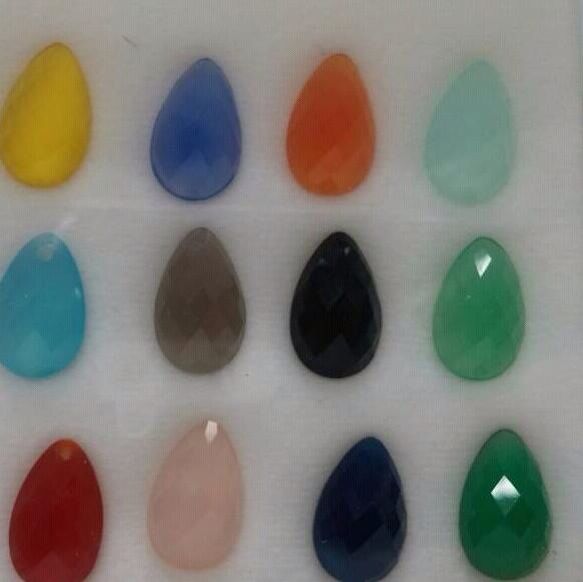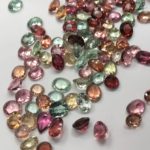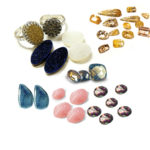Colored Chalcedony with Varieties
Quartz commonly forms as tiny grains or fibrous crystals, which may become packed together and stained in various colors by natural pigment. This produces an enormous variety of patterns, color banding effects, and wispy inclusions in a translucent matrix. Such material is known as cryptocrystalline ( Microscopically crystallized) quartz, and the colored gem varieties are called agate and jasper. The basic crypto crystalline matrix is called chalcedony.
View this post on Instagram
Chalcedony occurs throughout the world and is one of the most common and least expensive of all gem materials. Agate was known to primitive man and acquired a cloak of superstition. It was supposed to cure insomnia, breed prudence, and caution, and bring its owner strength and victory in battle. Engraved and intricately worked chalcedony tools were made thousands of years before the birth of Christ. Chalcedony is hard (7 on the Mohs scale), touch, and durable. Its fine grain allows for intricate and detailed carving and design. The various colored and patterned varieties have all been given individual names and have distinctive histories.

Carnelian, the modern spelling of the older “ cornelian,” was immensely popular in ancient Egypt and among Mohammedans. The color, ranging from Light brownish-red to deep clear red, is due to the presence of iron. Wax does not easily adhere to polished carnelian which made this material useful for seals. Natural carnelian comes from Brazil, Uruguay, India, and California.

Chrysoprase is a highly translucent, apple-green chalcedony that is frequently mistaken for jade. It is the most valuable of the chalcedonies colored green by traces of nickel silicate. Chrysoprase, usually cut into cabochons, beads, or cameos and intaglios, was popular in the Victorian era. Much of the “green onyx” and so-called chrysoprase sold today is dyed chalcedony. Fine natural chrysoprase comes from the Ural Mountains, California, Brazil, and Australia.
Prase is dark-green chalcedony, with little gems application.
Plasma is dark-green chalcedony with little translucency, sometimes with white or yellow spots Occasionally iron minerals produce red or brownish spots, giving rise to the name “bloodstone” or “heliotrope” Jasper is a catch-all term applied to opaque, colored chalcedonies. Often jasper displays no pattern, but the Body coloration is usually heavy and rich, in shades of Brown, red, green, and yellow. The material is dense and hard and takes a high polish. Related materials, usually gray or black in color, are chert and flint. A pale, reddish chert with inclusions of colorless quartz is commonly dyed blue and sold as “Swiss laps” or “ German lapis,” but these are not the same as lapis lazuli (see pages 103-104)
Agate is chalcedony in which the coloration takes the form of bands or wispy inclusions. Fortification agate Contains straight or concentric bands, while moss agate displays colored or black mineral inclusions that create fanciful landscapes and images in the chalcedony matrix. Agates, like jaspers, occur throughout the world. The tremendous variety of patterns has led to a wealth of names, many of them for specific localities. The finest moss agates come from India, and Montana, Oregon, Idaho, and Wyoming. Agates from Arizona, South Dakota, patterns and colors are almost endless.

Much commercial material is actually dyed chalcedony. Sard is basically like carnelian but tends to be more brownish and somewhat darker. Sardonyx consists of bands of sard, alternating with black and white layers. Onyx is black and white banded chalcedony. Black onyx commonly sold today is generally artificially blackened chalcedony. Brightly colored “onyx” in shades of red, blue, green, and yellow is dyed.
Chalcedony dissolved in circulating groundwater may replace buried wood and vegetation. The replacement so shows and delicate that even the cell structure of the original wood is sometimes preserved. Petrified wood, most notably from Arizona, can be very colorful, and entire petrified trunk and limb sections make interesting curiosities. Another name for massive silicon oxide is silica, and wood replaced by chalcedony is sometimes called silicified wood.
Most of the chalcedonies are cut as cabochons or Polished slabs, sometimes in unusual or fanciful forms. Chalcedony is ideal for carving and engraving, Fashioning into beads, spheres, and bowls, and making paperweights, pen holders, bookends, and boxes. Huge quantities of agate and jasper are tumble-polished for use inexpensive jewelry.
The city of Edgar – Obersein in West Germany has been an important gem-cutting center since the year 31 A.D. The entire city is dedicated to the art of gem cutting and carving and houses some of the great gem craftsmen of the world. German cutting has become synonymous with high quality. A variety of materials is cut, but the chalcedonies occupy a place of tremendous importance in the area of large-volume low-cost gems.


